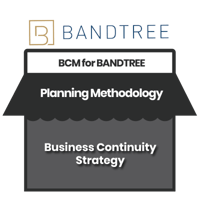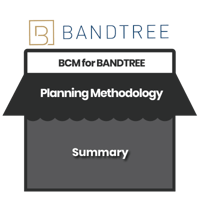Chapter 5
![BCM E2 PM [Business Continuity Strategy] Banner](https://blog.bcm-institute.org/hs-fs/hubfs/BCM%20E2%20Blog%20Banner/BCM%20E2%20PM%20%5BBusiness%20Continuity%20Strategy%5D%20Banner.png?width=750&height=150&name=BCM%20E2%20PM%20%5BBusiness%20Continuity%20Strategy%5D%20Banner.png)
Implementing Business Continuity Strategy Phase as Part of the Business Continuity Management Planning Methodology for Bandtree

In the context of Bandtree's Business Continuity Management (BCM) framework, the Implementing Business Continuity Strategy Phase is a pivotal component.
This phase focuses on developing, implementing, and refining strategies that ensure the organisation's resilience in the face of disruptions.
Through a careful analysis of the organisation's critical business functions and their dependencies, this phase outlines the necessary mitigation, prevention, and recovery measures.
For Bandtree, the implementation of a robust business continuity strategy is not just about recovery after an incident, but also about creating an agile environment that anticipates potential threats and can respond effectively.
These strategies are designed to safeguard the continuity of Bandtree's operations, particularly in the management of corporate properties, which form the backbone of the organisation’s core services.
This chapter will explore the specific strategies Bandtree can adopt to protect its vital operations.
Mitigation Strategies
Mitigation strategies aim to reduce the likelihood and impact of disruptions.
For Bandtree, this involves identifying risks associated with critical business functions such as property management, facilities maintenance, and tenant services, and then developing measures to address them. These strategies include:
- Regular Risk Assessments: Conducting quarterly risk assessments to identify new potential threats, such as cyberattacks on property management software or sudden shifts in market demands.
Example: Bandtree could partner with cybersecurity firms to assess and fortify the security of its property management systems, ensuring that tenant data and operational systems are safeguarded from ransomware attacks.
- Diversified Supply Chains: Ensuring that property maintenance services and suppliers are diversified to avoid dependency on single-source vendors. This reduces the risk of service disruption due to supplier failure.
Example: Bandtree may secure multiple contracts for key maintenance services (e.g., HVAC, plumbing) from different vendors to ensure a quick response if one vendor faces issues.
Prevention Strategies
Prevention strategies aim to stop disruptions before they occur by addressing the root causes. For Bandtree, these include systems, processes, and practices that reduce operational vulnerabilities:
- Business Process Standardisation: Developing standardised procedures for key functions like emergency response, facility management, and tenant communications. These processes ensure consistency and efficiency during normal operations and in times of crisis.
Example: Bandtree could implement a standardised procedure for crisis communication with tenants, ensuring that all stakeholders are informed and updated swiftly if a building faces operational challenges, such as power outages or fire hazards.
- Employee Training & Awareness: Implementing a continuous training program for all employees, focusing on crisis management, safety protocols, and business continuity roles. Prevention starts with an informed workforce that understands the importance of minimising disruptions.
Example: Conducting bi-annual fire and evacuation drills and providing property managers with specialized training in identifying early warning signs of infrastructure failures.
Recovery Strategies
Recovery strategies focus on restoring normal operations quickly and efficiently after a disruption. For Bandtree, the objective is to return to full capacity while minimizing downtime and operational losses:
- Recovery Time Objectives (RTO) and Recovery Point Objectives (RPO): Clearly defining acceptable RTOs and RPOs for each critical business function. For example, the recovery of tenant services should occur within 24 hours of a disruption, with no loss of tenant data.
Example: In the event of a power outage, Bandtree’s RTO for tenant communications is set to 4 hours, meaning the company aims to notify all tenants and implement backup systems within this timeframe to minimise service downtime.
- Alternate Site Plans: Developing and testing alternate locations for critical business functions. For instance, if Bandtree's headquarters becomes inoperable due to a disaster, having a secondary office site that can be quickly activated ensures minimal disruption.
Example: Bandtree may establish a partnership with a nearby building to act as a temporary headquarters if its primary location is compromised.
Summing Up ...
The Implementing Business Continuity Strategy Phase is essential for Bandtree’s operational resilience. By incorporating comprehensive mitigation, prevention, and recovery measures, Bandtree can safeguard its critical business functions and minimise the impact of potential disruptions.
This phase not only strengthens Bandtree's preparedness but also ensures its ability to recover swiftly and continue offering top-tier property management services, even in the face of unforeseen challenges.
As Bandtree moves forward with its Business Continuity Management Program, implementing these strategies will help the organisation become more agile, resilient, and able to maintain uninterrupted service to its stakeholders, ensuring the continued growth and success of the company in Brunei’s dynamic real estate market.
Resilience Redefined: Implementing BCM at Bandtree Sdn Bhd Brunei |
||||
| eBook 2: Implementing Business Continuity Management |
||||
| C1 | C2 | C3 | C4 | C5 |
 |
 |
 |
 |
 |
| C6 | C7 | C8 | C9 | C10 |
 |
 |
 |
 |
 |





![Register [BL-B-3]*](https://no-cache.hubspot.com/cta/default/3893111/ac6cf073-4cdd-4541-91ed-889f731d5076.png)



![FAQ [BL-B-3]](https://no-cache.hubspot.com/cta/default/3893111/b3824ba1-7aa1-4eb6-bef8-94f57121c5ae.png)
![Email to Sales Team [BCM Institute]](https://no-cache.hubspot.com/cta/default/3893111/3c53daeb-2836-4843-b0e0-645baee2ab9e.png)





